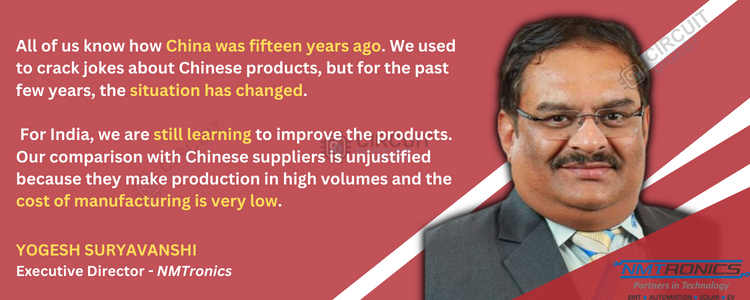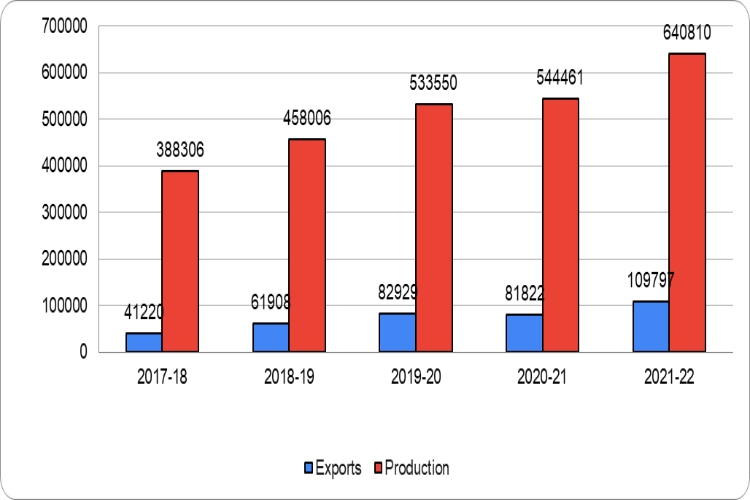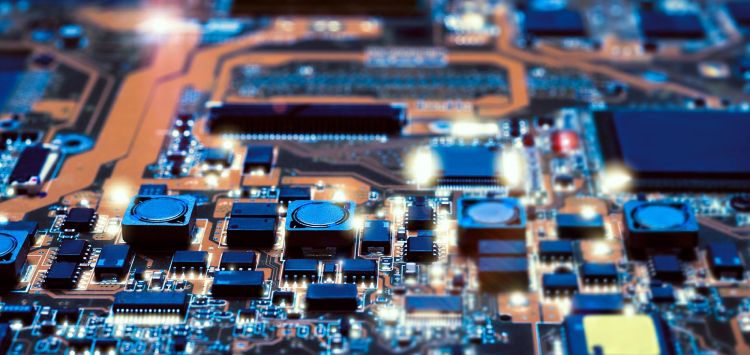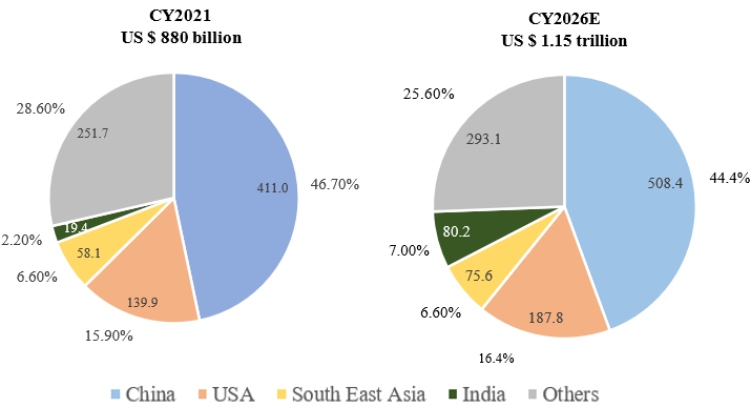
- 10 years ago, India imported 98 percent of mobile phones and at present 99 percent of the devices are made in India. In the coming days, 25 lakh people will work in electronics manufacturing.
- During the COVID-19 situation in 2021, China manufactured around $1.7 trillion worth of electronics, which contributed 28 percent of global production.
- China holds a 33 percent share of global exports with a value addition of $1,368 billion.
Times have gone by since electronic products manufactured by Chinese companies were treated contemptuously for their cheaper and inferior quality. But over the past fifteen to twenty years, China flipped the entire situation and earned the status of the “World’s Factory.” The country with 1.409 billion people turned out to be the world’s biggest electronics exporter, holding a 33 percent share of global exports with a value addition of $1,368 billion. The entire world was baffled by China’s quick dominance in the global electronics supply chain. Have you ever imagined, what’s the ‘Secret Weapon’ or the ‘Brahmashtra’ that helped China to spearhead the entire electronics ecosystem?
Many are still under the impression that it is China’s business monopoly scheme supported by the “Communist-Autocratic” rule, which follows no international regulatory or environmental compliance. Now, if you only abide by this thinking, then there is a misconception. In an effort to bolster the electronics manufacturing ecosystem, China offered a delectable strategic platter to the manufacturers, served with billions of dollars of subsidies in key infrastructures, cheap labor, and incentive schemes.

Highlighting the strategies of electronics manufacturing in China, Yogesh Suryavanshi, Executive Director and COO at NMTronics India, said, “All of us know how China was fifteen years ago. We used to crack jokes about Chinese products, but for the past few years, the situation has changed. They have educated themselves and kept on improving the quality of the products. The local customers and the government gave huge support to the manufacturing companies. For India, we are still learning to improve the products. Our comparison with Chinese suppliers is unjustified because they make production in high volumes and the cost of manufacturing is very low.”
When we speak about China’s dominance in this ecosystem, India is now turning out to be the biggest competitor in this industry. Interestingly, India had the potential to lead international electronics manufacturing starting from the early 80s. Today, it could have the lion’s share in this industry, much more or similar to that of China. But there is a ‘bolt from the blue’ due to which she outsources 80 percent of raw materials and components from China. Before we delve deep into that aspect, we need to understand the strategies implemented and deployed by China’s government.
Why is China able to board the global electronics growth bus while India is not?
Amid all the geopolitical scuffles, ‘Chip 4 Alliance’, and ‘China Plus One Strategy’, China still managed to establish itself as a global powerhouse for electronics manufacturing. The country already started investing in the electronics segment way back in the 1950s and commenced numerous research institutes and factories. In fact, students were given scholarships by the government to study electronics engineering abroad. Industry started growing at a staggering rate during the 80s and that’s when she was opened-up to the global economy. The global electronics company began investing in China to set-up its bases, and the nations started exporting its products.
Although various initiatives have been undertaken by the Chinese government in a span of 40-50 years, the nation has not been able to gain a reputation for producing quality electronic products in-house. This is when the government, policymakers, and manufacturers analyzed the situation conscientiously and started taking advantage of its own resources. They understood the mindset and demand ratio of their exporting nations and started making products as per the situation.

Since the late 90s, the Chinese government has provided billions of dollars in tax exemptions and subsidies to the companies and has strongly developed power plants, roads, rails, and ports. Most importantly, the biggest advantage is having 37 rare earth elements such as germanium, gallium, lithium, etc., which are extremely useful in the manufacturing of electronic items like electronic displays, hard drives, flat-screen monitors, and many more. On the other hand, the nation is furnished with huge volumes of cheap labor, which magnetizes global companies to set-up their units, backed by decreased production costs. The free-trade agreements also proved to be a game-changer for foreign firms in exporting their products to other countries seamlessly. Even during the COVID-19 situation in 2021, China manufactured around $1.7 trillion worth of electronics, which contributed 28 percent of global production.
India, on the other hand, was backed by numerous electronics companies, who were willing to manufacture large-scale electronics, including components. The country suffered a massive setback when, in December 1997, India signed the horrendous Information Technology Agreement (ITA-1) in Singapore. This is the moment when the nation’s dream of leading the global electronics value chain was shattered into pieces. According to the agreement, the nation had to wipe out tariffs on a variety of electronic products, and the import duty was brought to zero on products such as computers, telecommunication equipment, semiconductors, semiconductor manufacturing and testing equipment, and many more.
Now, you all might be flabber-gasted by the fact that India surpassed China in this industry throughout the 80s and the 90s. Domestic IT firms such as Wipro and HCL exported a huge chunk of IT hardware products to several nations, including China. For instance, in 1995, the share of domestic value-added products was around 70.27 percent, which unfortunately decreased by 45 percent in 2011. Kudos to ITA-1. The then government instructed the industry to concentrate on software and let China manufacture electronic items. There was a lack of liaison between the industry and the government.

In a recent SourceIndia event in Chennai, N Ramachandran, Managing Director, Mel Systems and Services, said, "Around 30 years ago, numerous electronic companies were not able to manufacture any kind of component because of the high restrictions imposed by the government in the industry. After every three months, manufacturers had to go to New Delhi to procure a new license for raw materials. The authorities during the late 90s even argued that India must focus on building software. We need real support for infrastructure and existing industries. The negative situation has changed dramatically because the government is now very proactive in supporting the industry.”
“There are some unforgivable reasons due to which India missed the bus numerous times, such as bureaucratic lassitude, lack of leadership with a clear vision, lack of infrastructure, and corruption. Today, India is generations behind in this industry, mostly in semiconductor manufacturing.”

Independent Journalist-CHOODIE SHIVARAM
India’s Imperative Strategies to Counter China’s Growth in Electronics Manufacturing
After several months of heated discussions with industry bodies, the UPA government has finally unleashed the nation’s first National Policy on Electronics (NPE) 2021, and under its aegis, Electronics Manufacturing Cluster EMC 1.0 was formed. Although it’s termed as the most comprehensive policy formulation, the NPE 2012 failed to attract big-ticket investments, seed high value-added manufacturing in the India ESDM ecosystem, or create large-scale employment, according to an exclusive report by the Economic Times. During that time, the country suffered a huge setback when it witnessed the biggest scams of the generation: 2G, CWG, and coalgate. The focus again shifted away from the electronics industry, and by 2014, the NDA government had come to power. India's electronics industry endured the pain of its wounds with immense stoicism. Since 2014, the new government has prioritized the growth of the ESDM ecosystem in India. In the same year, PM Modi stressed the imperativeness of making products in India and launched the nation’s first “Make-in-India” initiative that elevated confidence among the manufacturers in India. In 2017, exports of electronic goods reached Rs 41220 crores, and production reached Rs 388306 crore as per a report by the government. By 2022, exports reached Rs 109797 crore and production had reached Rs 6,40,810 crore.

Source: Ministry of Information and Technology (MeitY) and DGCA
The nation witnessed a huge impact in this ecosystem, when the government revised the National Policy on Electronics in 2019 and, under its aegis, launched Production Linked Incentive (PLI) for fourteen sectors worth Rs 1.97 lakh crore. Under NPE 2019, Modified Special Incentives Scheme (M-SIPS), Electronics Manufacturing Clusters (EMC), and Scheme for Promotion of Manufacturing of Electronic Components and Semiconductors (SPECS) have been announced to boost the industry. In fact, the Aatmanirbhar Bharat campaign initiated during the pandemic in 2020 also played a key role in motivating manufacturers to make products in India and highlighted the imperativeness of self-reliance in electronics manufacturing. This is when Foxconn, Pegatron, and Wistron, now acquired by Tata, started producing Apple’s iPhones in the southern part of India.

The nation is now one of the largest mobile phone manufacturing countries and world’s second largest smartphone market. The PLI scheme on mobile handsets and the Phased Manufacturing Programme (PMP) escalated mobile phone manufacturing to 290 million units in 2020-21 from 60 million units in 2014-15. Mobile phone exports from India will grow more than fivefold to USD 50-60 billion in the coming time from about USD 11 billion last year, Union IT and Communications Minister Ashwini Vaishnaw said. He said that 10 years ago India imported 98 percent of mobile phones and at present 99 percent of the devices are made in India. Around 10 lakh people work in electronics manufacturing. In the coming days, 25 lakh people will work in electronics manufacturing. The government has now targeted $300-$400 billion worth of total electronics production and $125 billion in exports by 2026. Semiconductors are one of the crucial electronic components, which were largely ignored by the previous governments. Industry leaders have been calling for a separate incentive scheme for this industry for a long time. PM Modi, along with this cabinet, launched the much-awaited incentive scheme of Rs76,000 crore to boost the ecosystem. The scheme has targeted Micron to set-up its first ATMP unit in Gujarat. Now, TATA group and CG Power also announced a new fab and ATMP unit in Gujarat and in Assam.
Highlighting more about the growth of the industry, Shri S Krishnan, IAS, Secretary MeitY, said, “Previously, the department was not looking to develop the core electronics, and the focus was mostly centered upon developing software, e-governance, and other aspects. But, in the past 5-6 years, the core electronics mojo has been back on track. We now have a very successful PLI on IT hardware, and 27 companies have signed MoUs and many of them have already started operating. This PLI offers benefits to the existing companies and provides subsidies as well. It recognizes that we are dealing with an industry where India has traditional strength, and we must use it in such a way that it benefits the country. Currently, 70 percent of PCBs used in India are still imported. Therefore, I urge industry bodies to work more closely with the government to give more suggestions on how to grow the industry more,” added Mr. Krishnan.
The Indian ESDM market contributed around 2.2 percent of the international market in 2021, which is expected to increase by 7 percent in 2026, claims an analysis of Frost and Sullivan. Now, when we again speak of China dominating the international electronics industry, the situation is now topsy-turvy owing to the augmenting geopolitical situation, supply chain disruptions, and the sudden spike in labor costs. Moreover, the global companies are now looking to shift their operations away from China and set-up bases in India, Philippines, and Vietnam.

Source: Frost and Sullivan
The effect of COVID-19 has had a massive impact on China’s electronics production. In Q1 2023, there is a 15 percent decrease in semiconductor production and a 13.8 percent decline in smartphone production, which has affected domestic companies such as Vivo, Xiaomi, and Oppo. It has ultimately resulted in 4.5 percent GDP growth and 3.9 percent industrial output in March. According to the survey by the Ministry of Industry and Information Technology (MIIT), the EMS companies in China contributed 0.9 percent year-on-year escalation in value-added and saw a 5.8 percent escalation in value-added by the electronics information manufacturing industry. The production of mobile phones witnessed 935 million units, of which 679 million were contributed by smartphones.
Will India Become the “World’s Factory” in Electronics Manufacturing by Replacing China?
The government of India has undertaken strenuous efforts over the years to help the nation compete in the global electronics value chain. The nation is definitely growing in terms of exports and manufacturing backed by fruitful schemes, but there are a certain set of challenges that need solutions. Keeping aside mobile phones and other IT hardware products, India imports a huge chunk of components and raw materials from China. According to last year’s data, around 80 percent of PCBs and sensors were imported from China. As per Money Control report, shipments from China to India have augmented by $98.5 billion in Q1 2023. It is an increase of 4.16 percent in imports. Electronic equipment worth $30.63 billion were imported to India from China in 2022.
Then labor is another key challenge for India’s electronics manufacturing industry. According to Vinod Sharma, managing director of Deki electronics, labor is definitely available largely, but they do not have basic education on how to operate a machine. When they come to the factory, they are completely confused, and training needs to be given to them from scratch. Equipment price and design is also the key barrier. The equipment to produce electronics and semiconductor goods are highly expensive. India does not have a proper ecosystem to manufacture equipment and the designs are also mostly done for the foreign companies. Industry leaders are now calling for more real India made designs.
In an effort to reduce component imports from China, the finance ministry has recently unleashed 30 percent anti-dumping duty on bare PCBs up to six layers. Strategically, India is now in a better position to become the “World’s Factory” in the coming few years, but China’s unlimited subsidies, lack of regulatory compliance, and free trade agreement could be a challenging situation for India. Experts also opine that USA and Europe’s geopolitical scuffle with China could also prove to be a game-changing situation for India. India is now signing agreements with various nations to develop its semiconductor and electronics industry.
It must be noted that the global economy has been in turbulence ever since the breakout of Covid in 2019. While US and China tensions predated Covid, things have been getting increasingly difficult and unpredictable, with one crisis following the other. The Ukraine- Russia War added immense stress to the global economy, especially in the areas of energy and materials, notwithstanding the immense human suffering and loss of property it has caused. Even as this war continues, there are growing tensions in the Middle East with Israel vs. Hamas standoff.
Speaking of India standing out as a bright spot amid the global tensions, Rajoo Goel, Secretary-General of ELCINA said, "In this entire milieu, India definitely stands out as a bright spot and beacon of hope. With our focus on the ESDM sector, India has been pulling out all the stops to enable the electronics ecosystem and establish itself as a serious player in the global industry. While our economy and markets are growing, demand growth outpaced supply, and we remained dependent on growing imports. Concerted efforts in the last few years have salvaged the situation somewhat. However, much more needs to be done to create a sustainable ecosystem, especially with respect to value addition and manufacturing of components."





